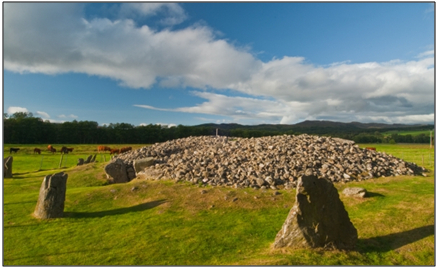Antiquities
Antiquities in the Lands of the Clan Grant
Loch an Eilein, the lake of the island, features a castle ruin of undetermined antiquity, but certainly older than eight centuries. The castle was occupied by Alexander Stewart, Earl of Buchan – the ‘Wolf of Badenoch’ – in the late 14th century, and used as a defensive redoubt on several occasions after that. In 1690, it was used by Jacobite forces retreating from the battle of Cromdale. The castle once had a causeway to the shore, but it became submerged when the water level in the loch was raised in the late 18th century to facilitate the floating of timbers down the River Spey.
This large standing stone with an incised cross – St. Figat’s Stone – is in the middle of the old churchyard at Inverallan near Grantown. Inverallan was among the first lands held by the ancestors of the Chiefs of Grant in Strathspey. The old churchyard is located between the River Spey and Inverallan House.
Castle Roy is a late 12th or early 13th century rectangular stone fortress. The castle was probably constructed by the Comyns (Cummings). It is built on a rocky hummock that was probably altered to improve the castle’s defensive capabilities. There is no trace of an encasing ditch or moat. The high walls are flanked on the north corner by a square tower and the break on the south angle was possibly the site of another interior structure. A pointed arched gateway pierces the northeastern wall and an arched window is on the opposite wall. Internally, there are indications that several lean-to structures existed at one time, but sadly, there is no specific information or history to indicate other details about the ancient site. The castle is situated near the present village of Nethybridge and overlooks the old Abernethy parish church.
The prehistoric antiquities on the former Corrimony estate date to the approximately 4000 years ago. The Stone Circle and Chambered Cairn are similar to many other ancient sites in north and eastern Scotland. The valley of Corrimony was exploited for over 4000 years, firstly by herdsmen and hunter-gatherers, and later by our prehistoric ancestors who learned to plant crops and harvest them later for their sustenance.
Although not specifically classified as an antiquity, the castle of Blairfindy was built by the Earl of Huntly as a hunting lodge circa 1586. It is said that another castle on the same site was owned by the Grants of Blairfindy. They were likely descended from William Grant, said to be a younger son of John Grant, younger of Freuchie, circa 1527. The Grants resided at Blairfindy even when the surrounding lands were held by the Earls of Huntly – the powerful family of the Gordon. Even though the castle was uninhabited from early times, it is not difficult to visualize the young children of the Blairfindy Grants and their young neighbors playing and reenacting famous battles of yore in the old ruin.
[A more comprehensive overview of the Antiquities in the Country of the Grants can be found under the heading “For Members Only” at “A History of the Clan Grant.]
James Grant, historian
Clan Grant Society – USA
standfast@charter.net





